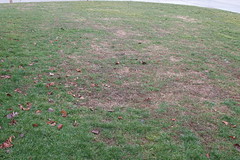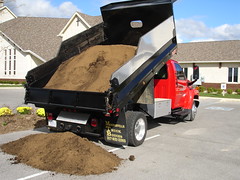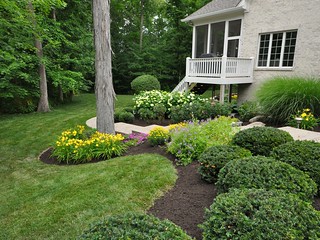Drought and high heat claimed a stranglehold on Indiana last summer. The historic 2012 drought forced mandatory water restrictions around Center Grove. As a result, many lawns and landscapes suffered extensive damage.

What was once soft, green grass, at Center Grove residents Terry and Jeanne Moore’s home slowly turned to a burnt orange intermixed with thatch and dirt. The plants in the landscape took on a desert look — dried leaves lay on the ground next to bare trees, bushes blazed orange-brown in the sweltering heat, and the wilted flowers begged for water. The drought took its toll on the lawn. Not knowing where or how to start the process of recovery, they called on Zo Zeigler, owner of Zeigler Landscape Service, to help them. “Living in our home for over 20 years, I had done nothing special for our yard with the exception of the regular lawn mowing and laying mulch down for the landscape beds on occasions,” said Terry.
According to Zo, our lawns and landscapes have taken a beating for the last few years. Our stressed lawns have endured disease, weeds, and bugs — all caused by the droughts – and our landscapes have not fared much better. However, we can read here and take certain steps in bringing our lawns and landscapes back to health.
Recovering the Lawn
Most of us are used to brown patches or dormant grass in our lawns at winter’s end. But if drought repair wasn’t done last fall, “these patches are more likely dead than dormant,” Zo said. In these areas, the dead grass becomes matted and tightly woven. When this matting occurs, it is hard for new seed to penetrate the soil and germinate.
In a typical growing season, dormant grass seeding takes place in February or March, while the ground is still freezing and thawing. In order for the seed to germinate the temperature needs to remain above 55⁰. The warmer the soil, the faster the seed will germinate. “But it has not been a typical year for lawns,” Zo said. “If drought repair was not executed this past fall, in March I would suggest aerating the ground before seeding.” It is also important to wait 12 weeks after aeration and over-seeding before starting lawn treatments. Maintaining your lawn through regular grass services is also essential to ensure its lush green appearance throughout the year.
With the potential for another hot summer and to lessen more stress on our lawns, Zo suggests applying these products around the following holidays:
- Easter: Apply pre-emergent crabgrass control
- Mother’s Day: Apply weed and feed post-emergent
- Father’s Day: Apply grub control
- Labor Day: Apply fall lawn food and fertilizer
- Halloween: Apply winter guard
“For the do-it-yourselfers, homeowners should ask a store’s lawn expert about which product is right for their lawn. Not every product uses the same concentration of chemicals and nutrients. They must be aware of what their lawn is doing. It’s also important for the homeowner to follow the instructions on the bottle, including when to water.”
In talking about the health of restoring this year’s lawns, Carl Bigelow, professor for the Department of Agronomy and assistant at the Purdue Extension Office, said: “It makes sense for those who truly care about their lawns to consider hiring professionals to aid in the recovery process. Professionals keep up with correct application schedules, select appropriate fertilizers and seed, scout for pests, and know how to best prepare your turf for future stresses.”

Recovering with Mulch
For landscaping plants, Zo explained that homeowners will just have to wait to see if the trees, shrubs, and flowers have survived. But, he did say that grass competes with surrounding plant material for the soil’s nutrients. Mulching around the base of trees, shrubs, and flowers will significantly boost a plant’s health. “A good layer of mulch applied to a landscape will reduce soil erosion during heavy rainfall,” Josh McCarty, owner of McCarty Mulch & Stone, said. “It will also aid your plants during seasonal weather, retaining moisture in the soil during summer heat, and insulating roots against winter freeze.”

How does one select the correct protection for their plants? “The final decision really comes down to personal preference.” However, Josh did suggest a homeowner consider the following questions:
- What stressors affect the garden? Wind? Water? Slopes?
- What price range can you afford for mulch?
- Do you want low-maintenance mulch?
- What kind of look are you after?
Mulches come in two types — wood and rock. Both lend their own unique style to a landscape. Rock mulch encompasses the whole color spectrum; wood mulch comes in natural and dyed colors. Dyed wood mulch is now an option in garden landscapes. This mulch comes in a variety of hues and shades. The application of non-toxic dye mulches in a landscape can aid in the creation of a specific desired aesthetic appearance. “People may use dyed mulches to offset their plants with a bold contrasting color, such as our finely ground red or black wood fiber mulch,” said Josh. “Often called the ‘Mock Cypress,’ homeowners like the golden colored mulch to blend their home, surrounding soil and hardscapes together.”
Many people question the safety of dyed mulch. “Our dyed mulch is made with non-toxic Heartland Enriched colorants that are processed using ‘color-safe’ technology. This colorant is completely safe for plants, pets, and children. As a matter of fact, some of the same materials used to make the colorant are the same materials commonly found in cosmetics.”

When considering mulch, gardeners need to consider what happens to their plants beneath the dirt. As wood mulch decomposes, it adds nutrients to the soil, assisting in the landscape’s root system. This is especially helpful to areas containing small plants, such as annuals and perennials.
Termed the “permanent mulch,” rock mulch makes excellent groundcover for those who covet low-maintenance landscapes. For homeowners with a slope in their landscape, rock is excellent for erosion repair and prevention and it doesn’t puddle during heavy Indiana downpours. “Because of its permanent nature, rocks can be incorporated into fixed garden elements like trees and fountains, creating a bold design element,” said Josh.
Recovery
According to Zo, it will take time for some lawns and landscapes to recover. Why? Because there are many factors that affect recovery time – different soils in the area, the amount of water that is applied, and the type of plants and grass seed that is used. It takes a “common sense” program, such as the ones listed in this article, with a lot of time and patience.
You can find the companies mentioned in this article online by clicking the their link:
 Tonja Talley has called Center Grove home since 1993. An 11-year bi-lateral lung transplant survivor, Tonja enjoys speaking on behalf of the Indiana Organ Procurement Organization. She also volunteers for the CF Foundation, byTavi, and her church.
Tonja Talley has called Center Grove home since 1993. An 11-year bi-lateral lung transplant survivor, Tonja enjoys speaking on behalf of the Indiana Organ Procurement Organization. She also volunteers for the CF Foundation, byTavi, and her church.






Comments 1